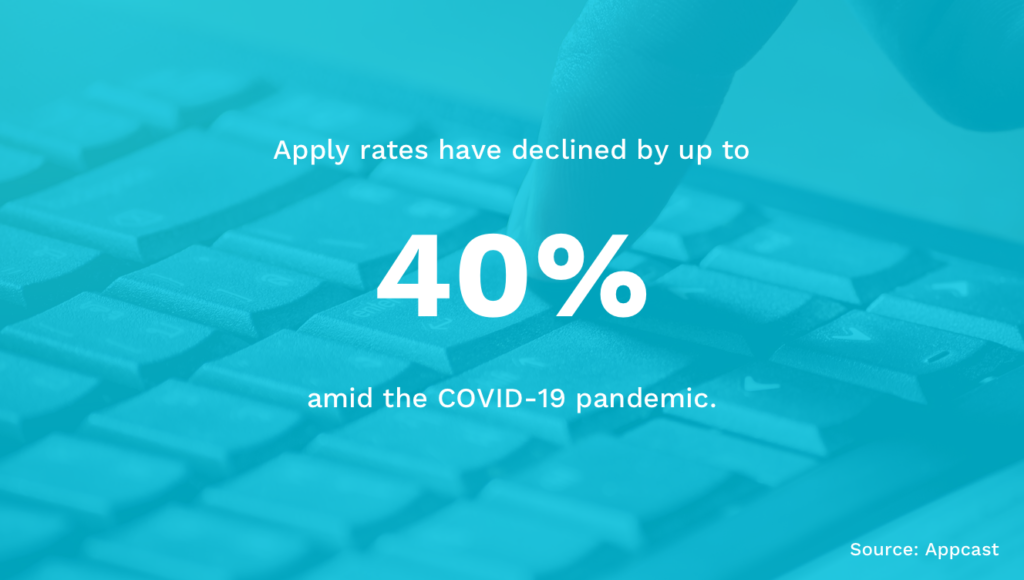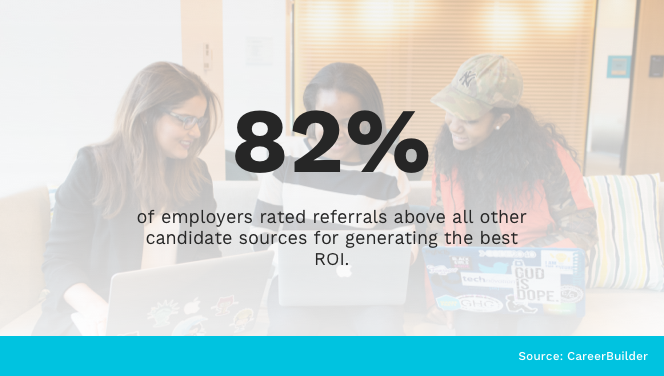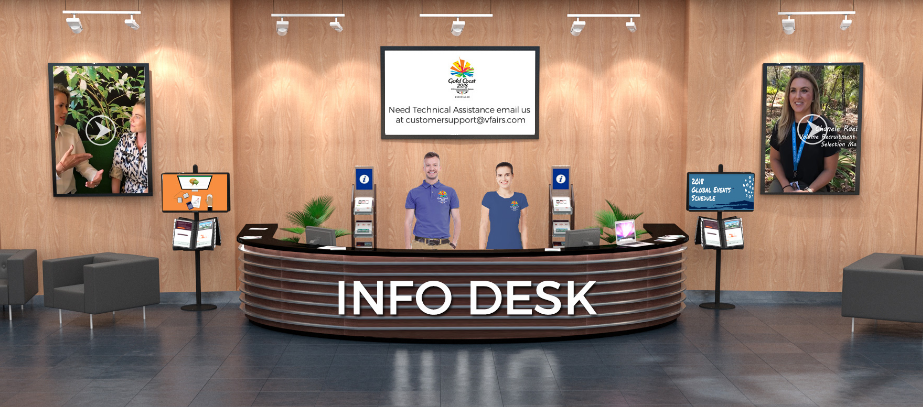“The country’s wealth is not necessarily built on its own natural resources;
it is achievable even in their absence. An essential resource is human.
The state only needs to create a basis for the flourishing of human talent.”
Margaret Thatcher
Same as the country’s wealth, business success depends mostly on the right people inside it. The first and foremost step is a future-oriented recruiting strategy.
The triggers shaping the recruiting trends have changed. The unemployment rate grew rapidly because of the worldwide COVID-19 pandemic and the economic downturn it brought about. What’s more, gig economy continues to expand and skills gaps in the workforce are more apparent than ever.
Under these conditions, recruiting tactics have to evolve and adapt to the new reality. So what tactics should you sharpen up?
What’s in?
Like what you see?
Don’t miss out. Subscribe to our quarterly digest to get the latest TA and TM resources delivered right to your inbox.
1. Doubling down on recruitment marketing
Recruiting marketing is a set of methods that increase potential candidates’ interest in the company as an employer. Its aim is to inform candidates about the company’s vacancies, warm-up their interest, convince them to respond to offers, and help them picture the organization as their next employer.
A good recruitment marketing strategy enables you to attract relevant candidates to open vacancies and raise the employer brand awareness.
It might seem counter-productive to double down on this recruiting tactic when there are a lot of candidates available on the market now. However, the top candidates are probably applying to multiple vacancies and you need to get them interested in your company. What’s more, you can’t afford to waste precious resources on unqualified candidates.
So what should you focus on when creating your recruitment marketing strategy?
- Create an ideal candidate profile. It is not enough to determine the requirements for education and experience. It is crucial to understand what goals, values, motivations, and characteristics a person should have to succeed in the specific role.
- Define the interests of an ideal candidate: salary, career prospects, comfortable office, social package, latest technologies, corporate values, etc.
- Create informative content to convey a positive employer image: blogs, videos, interviews, collaborations, news and mailing lists, etc.

Even through the unemployment rate has increased, people are hesitant to apply for new jobs because of the uncertainty as well as the government support packages. So you need to be creative with your recruitment marketing efforts to get candidates to apply to your openings.
2. Automation of candidate selection
Digital technology is strengthening its position within recruitment and HR. While applicant tracking system (ATS) is now a base of many recruiting teams’ toolbox, companies need to go further than that to hire effectively while maintaining fair hiring practices.
If you want to improve recruiting efficiency and mitigate against hiring bias, you can automate your candidate selection through matching technology.
Matching technology is essentially a set of assessments candidates go through that evaluate them on competencies and skills predictive for success on the job. A recruiter can then decide based on the assessment scores if a candidate would be a good fit for the role.
Automated candidate selection process significantly reduces the operational work for your recruiting staff. This means more time for the ‘human’ side of recruiting – engaging and interviewing the most qualified candidates.
3. Strengthening referral recruiting
Right now, recruitment teams need to be budget conscious. That’s why having a high-quality referral program can help you cut down sourcing costs and become an invaluable recruiting tactic. Did you know that people tend to trust the employees 3X more than they trust the companies to provide information on what’s like to work there?
Your employees can be your biggest asset when it comes to sourcing qualified candidates. In return, they receive a particular reward.
Referral recruiting is especially useful when you need to fill a challenging role and there is no room for error. Referred candidates are often well qualified for open positions, as well as have the right culture fit, since they are pre-selected by those who already work for the company.
If you’re still not convinced, here are a couple more benefits of a referral recruiting program:
- Employees are familiar with the company’s culture so that they can refer candidates who would really thrive at your organization.
- The quality of hire and employee retention increase – referred employees feel responsible for their referees; they are more likely to stay in the company longer.
The key to having a successful referral program is to cultivate a working environment that attracts and retains the best employees, so they are comfortable referring people that they know to work for you.
When your company has a strong culture, core values and leaders who know how to develop teams, it won’t be difficult to ask your employees to help you attract great candidates for your open positions.

A good referral program can provide you with great value for money in your sourcing and recruiting strategy.
4. Using work samples and assignments
Using work samples and assignments is an employee selection method growing in popularity.
Why is that?
84% of companies consider it at least somewhat effective in selecting employees. Furthermore, this selection method increases the objectivity of the hiring process and helps verify a candidate’s skills and competencies in a realistic setting, working on an actual task.
Also, an applicant has an opportunity to see first-hand what the job would entail and make an informed decision whether or not it’s something they’re interested it.
Here are a few methods you can use in your selection process:
- Online case-based tests — These can help evaluate, for example, coding skills.
- Individual cases — A task relevant to the job in question during which the situation analysis, research skills, and communication skills are tested.
- Team tasks — Cases that test candidates’ abilities to work in a team, come up with a solution in a difficult situation, and advocate for it within the team.
Including a work sample or an assignment in your recruitment process is beneficial to your organization in several ways:
- Transparency. At the case interview, everything becomes clear: the interviewer sees how the candidate approaches the tasks, their knowledge of the industry, how they can search for information and analyze it.
- Practical benefit instead of “What are your weaknesses” interview. The case interview helps you understand how the candidate will act in a particular situation and what their work style is.
Using work samples and assignments doesn’t mean that you should abandon other selection methods. On the contrary, it is the most effective when combined with a structured interview, a peer interview, or other techniques.
5. Balancing between motivation and qualification
Companies around the world say that they are struggling with skills gaps and they have trouble recruiting people for specialist positions. However, at the same time, they don’t invest enough in developing and educating their employees.
So what’s solution to this?
Organizations need to learn to recognize high potential and motivation in their candidates and then teach them the necessary skills. This means that they have to strike a balance between an applicant’s motivation and their qualification in the hiring process and be dedicated to the employees’ growth once they get hired.
Why is it worthy of investment?
- You will recognize patterns and bottlenecks in career development, be able to analyze skills gaps to better plan for future needs and close the gap.
- It will help keep your workforce engaged by offering tailored learning journeys
- It will support your employee retention efforts.
6. Working on your employer brand
Perhaps, this is the most crucial element in attracting, hiring, and retaining great talent. 72% of leaders in the recruitment field across the world agree that employer brand has a significant impact on hiring. Remember, the brand is a reputation, which is built by painstaking work and emotions.
Employer branding has a wide range of different aspects, so your employer branding strategy needs to be holistic if you want to stand out. The areas you can improve on include:
- internal and external value communication
- building your online presence through your career pages, social media, employee blogs, and more
- intensive training of specialists and managers about employer brands
- brand management by experienced employees and strategists
- diversity management
- involving employees in the processes
- optimizing candidate journey process
- managing the employer reputation and reviews
- presenting the awards, bonuses, training opportunities and workshops
- organizing events, competitions, and exhibitions.
7. Use data to improve your hiring process
Hiring great candidates is a targeted effort rather than shooting in the dark. Tracking the right recruiting metrics and KPIs enable you to understand how to can optimize your process and which recruiting tactics work best for you.
In addition to the essential metrics like application completion rate, qualified candidate rate, cost- and time to hire, talent analytics helps you predict your future workforce needs, as well as conduct workforce risk analysis such as demographics, retention, career bottlenecks, and talent challenges.
You can also use global external insights, e.g., about the key competitors and other market players currently seeking the same skills, to learn about your competitors’ recruiting tactics and see what the best practices out there are that you could adopt.
8. Hosting virtual hiring events
Virtual hiring events and job fairs have increased in popularity amid the COVID-19 pandemic. To set up a meetup or organize an event has always been one of the best ways to find and engage new talent. It all changed in 2020 when the world has been forced to stick to strict social distancing measures to curb the spread of the virus.
With these measures in place, it is challenging to bring employers and job seekers together in one place. Though, the good thing about it is that the whole world went online. Thanks to technology, candidates no longer have to walk into a crowded room just to spend a few seconds face-to-face with a potential employer. Instead, this happens in a virtual environment.
Despite the redundancies and layoffs caused by the pandemic, many companies – for example, essential businesses – are now actively recruiting staff. That’s also why virtual job fairs expand their scope and become a secure option for employers to get the word out about their openings. There are plenty of benefits of a virtual job fair, e.g., shorter time commitment, lower costs, fewer geographical limitations, and overall accessibility.
If you’re organizing a virtual hiring event, don’t forget to take enough time to promote it and create plenty of opportunities for the job seekers to interact with you as an employer. That way, you’re making sure that you can fill your openings faster with the best candidates.

A virtual information desk at your online hiring event is a great place to facilitate conversations with your candidates and answer any questions that they might have.
9. Reaching out to great applicants from the past
Shortlisting candidates from 500 to 10 is more straightforward than choosing which of those final ten will be hired. Those candidates that didn’t get hired can become your best candidates for future openings – so keep their profiles and contact data handy.
This is especially useful if you’re hiring for the same or similar roles on a regular basis.
Same with the previous employees who left sometime — if the employee left on good terms, they may be the perfect candidate for their old, different, or a new role higher up on the ladder in the future. As a bonus, you already know that such a person is a great organizational fit and they will require less time for onboarding.
Modern employers maintain talent pools where they collect information about the best job applicants who came for an interview and talent known from other sources. They also have a system in place to search this talent pool whenever there’s a new opening.
Over to you
To succeed in the ever changing labor market, recruiting teams will be called on to develop new skills, master new metrics, adopt new tools, and employ new recruiting tactics. Moreover, recruitment is becoming an essential element of any business strategy and having a profound business impact.
The companies are indeed cutting down their hiring plans and budgets today. At the same time, it doesn’t mean less work for the recruiters. Their main task will be to recognize the needed skills and potential in candidates from different talent pools, manage different sources of talent (gig workers, part-timers, full-time employees), fill skills gaps, understand the drivers of high performance and engagement, ensure that your workforce acquires future-oriented, relevant knowledge, recognize patterns and bottlenecks in career development and keep your workforce engaged by offering tailored learning journeys.
But remember, the future of recruiting won’t be something that happens to you — it’ll be something that you help create!
| About the Author: “Let us rather invent tomorrow than worry about yesterday’s events.” Being a graduate of four universities, Maria Semenova speaks six languages, has dozens of popular scientific publications and numerous work experiences in leading companies. With strong skills in strategic negotiation and stakeholder management, content marketing, branding & positioning and sales, Maria is HRForecast’s spokesperson to all questions of people and labor market analytics, market intelligence, talent availability in the context of digitalization. For more information about other works of the author, follow Maria on LinkedIn. |


